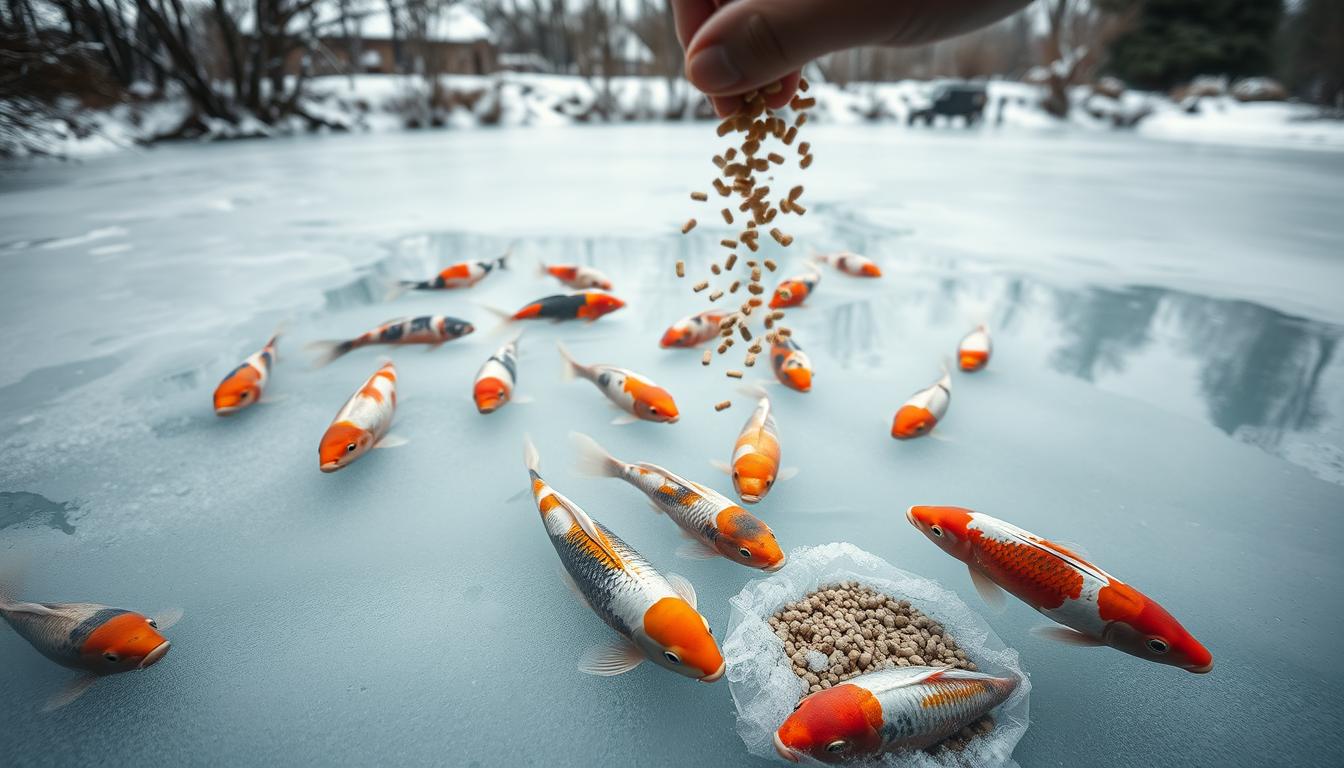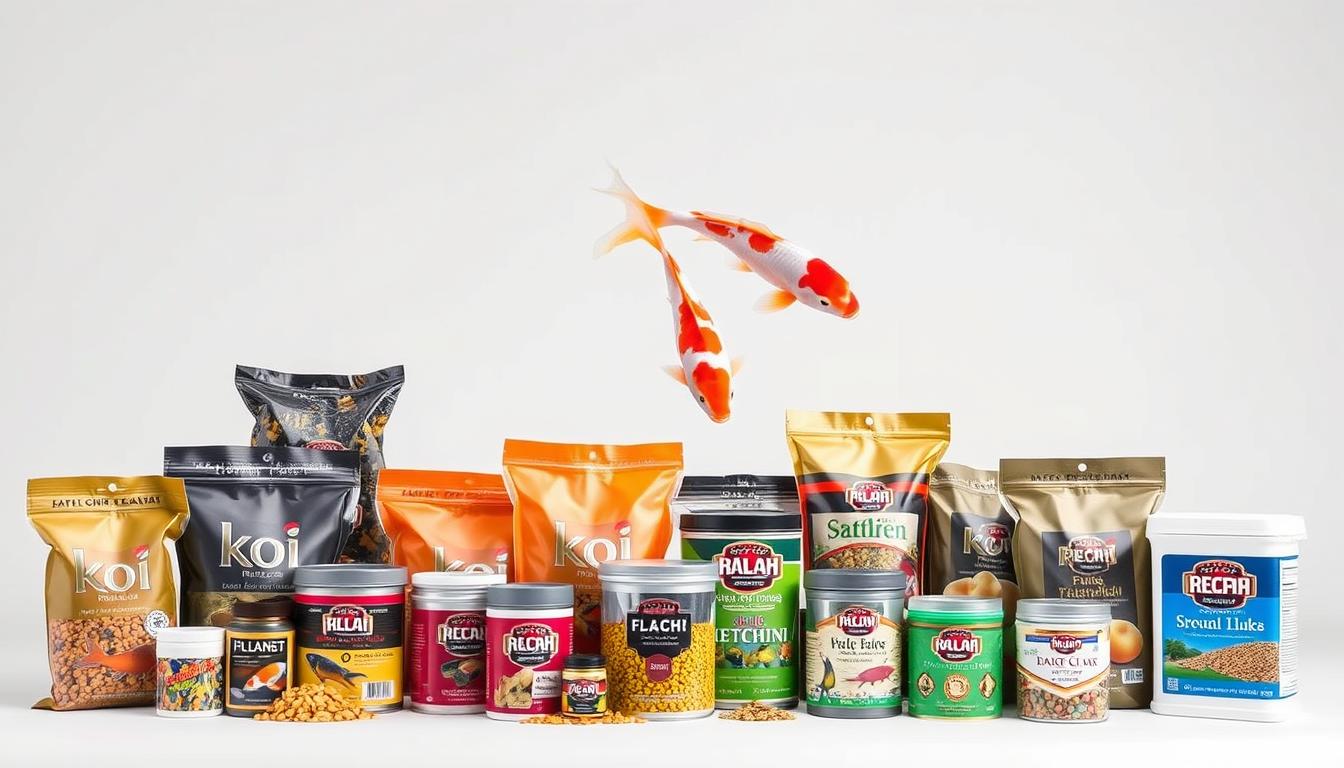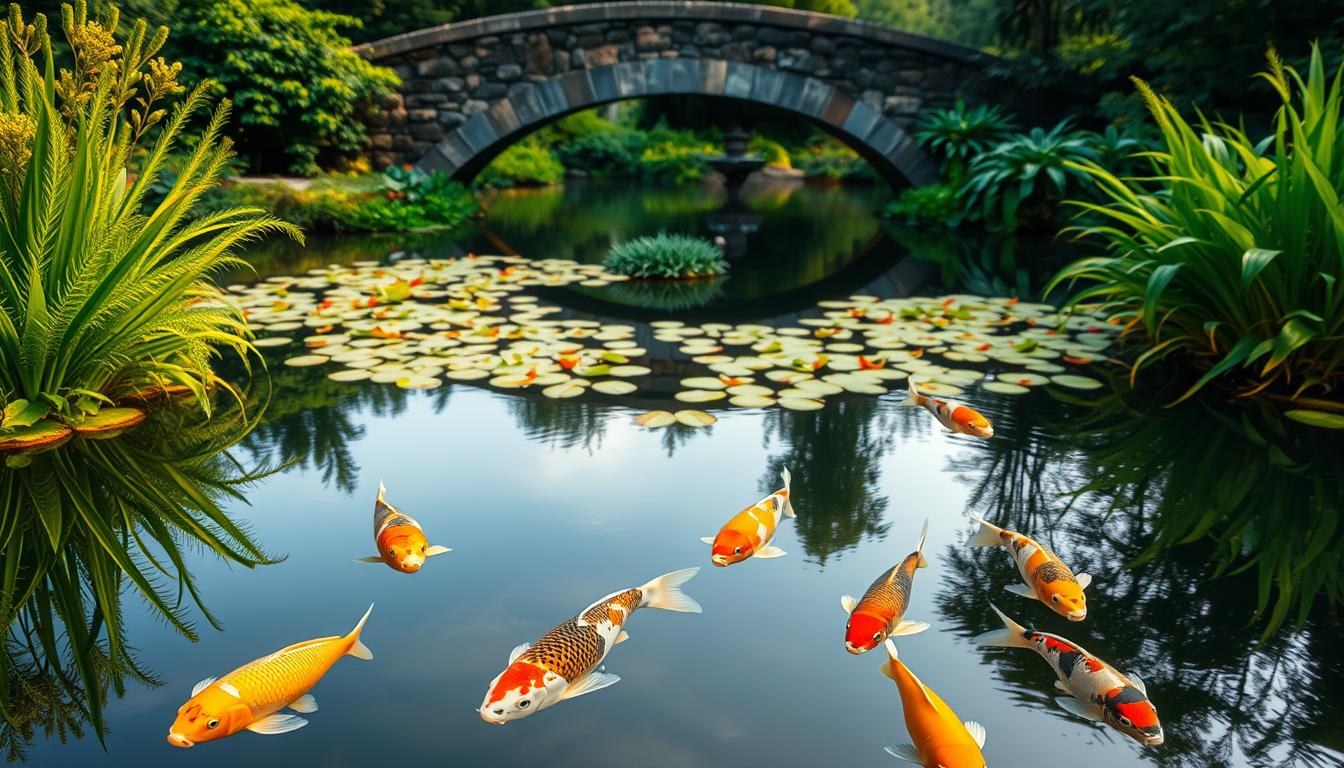Do Koi Fish Need Different Food in Summer vs Winter Seasons?
This post may contain affiliate links.
Did you know these vibrant pond dwellers can live over 50 years with proper seasonal care? Their survival hinges on adapting diets to temperature changes – a detail many enthusiasts overlook.
Originally bred from common carp in Japan, nishikigoi (brocaded carp) have become living art. Their jewel-toned scales symbolize perseverance and luck, making them more than decorative pond additions. But their cultural legacy depends on understanding their biology.
Water temperature dramatically affects metabolism. In summer, they devour protein-rich meals to fuel growth. Winter’s chill demands low-protein, wheatgerm-based options. Getting this wrong risks digestive issues or malnutrition.
Key Takeaways
- Seasonal diets prevent health issues and support longevity
- Metabolism shifts require summer/winter nutritional adjustments
- Originating from carp, these creatures have unique dietary needs
- Proper feeding honors their Japanese cultural significance
- Expert tips balance aesthetics with biological requirements
Introduction to Seasonal Feeding for Koi Fish
Balancing tradition and biology is key to maintaining the health and beauty of these living artworks. Their jewel-toned patterns aren’t just decorative – they reflect centuries of Japanese breeding focused on harmony with nature. As water temperatures swing between summer heat and winter frost, their dietary needs shift dramatically.
Outdoor ponds act as natural thermometers for ornamental species. When mercury rises above 70°F, metabolism accelerates, demanding protein-rich meals. Below 50°F, digestion slows to a crawl. Feeding the wrong food during temperature extremes can lead to wasted nutrients or dangerous bloating.
Modern pond designs help stabilize environments, but owners must still adapt care routines. As one aquatic specialist notes:
“These creatures thrive when their meals mirror seasonal rhythms – it’s how they’ve survived winters for generations.”
Three core factors determine feeding strategies:
| Season | Ideal Temp Range | Food Type | Frequency |
|---|---|---|---|
| Summer | 68–86°F | High-protein pellets | 3–4x daily |
| Winter | Below 50°F | Wheatgerm-based | 1x weekly |
Beyond biology, there’s cultural wisdom in seasonal care. Many enthusiasts believe proper feeding honors the good fortune these animals symbolize. Upcoming sections explore how to adjust portions, select quality brands, and maintain water clarity through temperature swings.
Understanding Koi Fish Biology and Nutritional Needs
The shimmering inhabitants of ornamental ponds trace their lineage back to ancient carp species. Originally derived from amur carp (Cyprinus rubrofuscus), these creatures evolved through centuries of selective breeding. Their biology directly impacts dietary requirements – a fact critical for maintaining vibrant color and pattern variations.
Seasonal Metabolism Variations
Water temperature acts like a biological switch. When temperatures climb above 68°F, metabolism speeds up by 300%, demanding frequent protein-rich meals. Below 50°F, digestive enzymes slow dramatically. Feeding high-protein foods in cold months risks undigested food rotting in their system.
Key Nutrients for Every Season
Summer diets focus on growth-supporting elements, while winter meals prioritize easy digestion. Modern varieties developed through breeding programs often require tailored nutrition to maintain their distinctive markings. A balanced approach ensures both health and aesthetic appeal.
| Season | Protein | Carbs | Fats | Key Vitamins |
|---|---|---|---|---|
| Summer | 35-40% | 20% | 5% | A, C, D |
| Winter | 15-20% | 40% | 3% | B-complex, E |
Brilliant color patterns in new varieties koi often reflect breeding success and dietary balance. Wheatgerm becomes essential in colder months for its digestible carbohydrates. As one breeder notes:
“Their scales tell the story of what’s happening inside – dull colors often signal nutritional gaps.”
Understanding these biological roots helps owners create feeding plans honoring both the amur carp‘s heritage and modern koi varieties‘ needs. Proper nutrition sustains not just life, but the living artistry these pond dwellers represent.
Summer Feeding: Optimizing Nutrition When Temperatures Rise
When pond temperatures climb above 70°F, metabolic rates surge like engines revving in overdrive. This biological shift demands precise nutritional adjustments to support energy needs without overwhelming digestive systems. High-energy, easily digestible meals become the cornerstone of warm-weather care.
Ideal Foods for Warm Weather
Premium summer diets focus on proteins and nutrients that fuel growth without taxing digestion. Spirulina-rich pellets enhance color vibrancy, while shrimp meal provides muscle-building amino acids. Wheatgerm blends remain useful during early summer transitions.
| Food Type | Protein % | Key Benefit | Daily Servings |
|---|---|---|---|
| Spirulina Pellets | 38% | Color enhancement | 2-3 |
| Shrimp Meal Mix | 42% | Muscle development | 1-2 |
| Wheatgerm Blend | 25% | Easy digestion | 1 |
Adjusting Feeding Frequency
Active pond inhabitants may require up to four small meals daily during peak heat. A good rule? Offer 1-2% of body weight per fish, split across feedings. Larger specimens often need proportionally less than juveniles.
Some ornamental varieties like Kohaku thrive in these conditions due to their resilient nature. Breeders of prized specimens often customize diets:
“Top-tier bloodlines receive supplemental probiotics in summer – it’s like giving athletes personalized training meals.”
Always monitor water parameters closely. Warmer ponds demand weekly testing for ammonia and pH balance to prevent nutrient overload. A well-maintained environment lets nutritional strategies shine.
Winter Feeding: Strategies for Cold Weather
As icy winds sweep across ponds, cold-blooded residents enter survival mode. During winter dormancy, their digestive systems operate at minimal capacity – a natural adaptation to conserve energy. This biological slowdown means feeding routines require careful adjustment to match their reduced needs.

Owners must balance nutritional support with environmental protection during these chilly months. Three critical factors determine success: portion control, food composition, and habitat monitoring.
Preventing Overfeeding During Dormancy
Metabolism drops by 70% when temperatures fall below 50°F. Switch to wheatgerm-based formulas that dissolve easily, reducing waste. Feed no more than 1% of body weight per fish weekly – overfeeding risks toxic ammonia spikes.
| Winter Feeding Guide | Portion Size | Frequency |
|---|---|---|
| Small specimens | 0.5g per fish | Every 10 days |
| Large adults | 1.2g per fish | Weekly |
Maintaining Water Quality in Cold Temperatures
Frozen surfaces limit oxygen exchange, making water testing crucial. Remove uneaten food within 15 minutes and invest in a pond aerator. As Dr. Emily Torres advises:
“Clear ice patches allow gas exchange while protecting inhabitants from predators – it’s nature’s safety blanket.”
Proper winter care helps these ornamental creatures thrive for decades. Regular health checks and adjusted feeding schedules ensure they emerge vigorous when spring arrives.
Assessing Your Koi Pond Environment
The secret to vibrant pond life lies in meticulous habitat management. Proper water conditions and structural design work together to support aquatic health through seasonal changes. Let’s explore how to create an ecosystem where ornamental species thrive year-round.
Water Temperature Management
Maintaining stable temperatures prevents stress on cold-blooded inhabitants. Use floating thermometers to monitor daily fluctuations. During summer, shade structures help reduce overheating. In winter, pond heaters or aerators prevent surface freezing while allowing gas exchange.
Pond Infrastructure Considerations
Quality filtration systems remove waste and maintain clarity. Skimmers paired with biological filters create a balanced environment. Consider these essential components:
| Equipment | Function | Maintenance |
|---|---|---|
| UV Clarifier | Controls algae | Bulb replacement yearly |
| Bottom Drain | Debris removal | Monthly inspection |
Recognizing lineage matters – specimens bred under Zen Nippon Airinkai standards often have specific habitat needs. As one certified breeder notes:
“Premium bloodlines require pristine water parameters to maintain their genetic potential.”
Seasonal transitions demand extra vigilance. Test water weekly for pH balance and ammonia levels. Partial water changes (10-15%) help maintain stability during temperature shifts. Plant buffers like water lilies provide natural shade and shelter.
Upgrading infrastructure? Consider adding aeration systems for oxygen distribution. These improvements support diverse fish species while honoring the artistry behind these living jewels.
Koi Fish Buyer’s Guide: Choosing the Right Food
Nutritional choices directly impact the health and vibrancy of ornamental pond dwellers. Selecting quality meals requires matching formulas to specific needs—whether caring for show-quality specimens or beloved pet companions. Genetic lineage plays a starring role, as different varieties evolved distinct dietary preferences.

Premium brands often cater to specialized requirements. For example, high-growth formulas suit young carp, while color-enhancing blends benefit red-and-white patterned types. Always check labels for these key elements:
| Brand | Protein % | Best For | Price Range |
|---|---|---|---|
| AquaGrow Pro | 38% | Juveniles | $$ |
| Chromax Boost | 28% | Color enhancement | $$$ |
| WinterWheat | 18% | Cold months | $ |
Higher-priced options often include probiotics and vitamins missing in budget lines. As breeder Hiroshi Tanaka observes:
“A $50 bag feeding $1,000 specimens? That’s like putting regular gas in a Ferrari.”
Portion sizing matters too. Smaller varieties need bite-sized pellets, while jumbo carp require larger kibble. Always verify expiration dates—stale food loses nutritional value rapidly.
For rare types, consult specialists about custom blends. Regular health checks reveal if dietary adjustments are needed. Remember: proper feeding honors both the carp’s biology and your role as their caretaker.
Understanding Cost Factors: Price, Variety & Quality
Did you know some ornamental carp command prices rivaling luxury cars? The cost spectrum ranges from affordable pond pets to showstopping specimens valued at over $1.8 million. This pricing diversity reflects genetics, colors, and patterns – factors that also influence food quality needs.
Budget-Friendly Feeding Tips
Smart feeding practices keep costs manageable without compromising health. Buy food in bulk during spring sales, and store it in airtight containers. Focus on formulas with 25-30% protein for most adult carp – these balance nutrition and price effectively.
| Food Type | Protein % | Key Features | Price Range |
|---|---|---|---|
| Standard Pellet | 28% | Balanced nutrition | $15-$25/5lbs |
| Seasonal Blend | 32% | Temp-specific | $20-$35/5lbs |
| Color Enhancer | 25% | Pattern support | $30-$50/5lbs |
Investing in Premium Koi Food
High-end specimens like the Kohaku variety – known for crisp red-and-white patterns – often require specialized diets. Champion bloodlines may need foods with spirulina additives or probiotics. As one auction winner shared:
“Feeding my Grand Champion $300/month food seems steep – until you see her compete against $500,000 carp.”
Track consumption rates based on number of specimens and their size. A 10-fish pond typically needs 25% less food per carp than individual feedings suggest. Always match portions to seasonal activity levels for optimal fish practice.
Regional Considerations: Feeding Practices in the United States

Geography shapes more than landscapes—it directly impacts how ornamental carp thrive. Across America’s varied climates, from Arizona’s dry heat to Minnesota’s icy winters, pond owners adapt traditional Japanese methods to local conditions. Water temperature swings in the U.S. often exceed those in native habitats, requiring customized feeding plans.
Japanese ponds typically use natural clay liners and shallow depths, while American designs favor concrete or rubber liners with deeper basins. These structural differences affect how quickly water warms or cools. A breeder in Texas notes:
“Our carp need 30% fewer winter feedings than those in traditional Japanese setups—deep ponds retain heat better.”
Three key regional factors influence care routines:
| Region | Common Challenge | Feeding Adjustment |
|---|---|---|
| Southwest | High evaporation | Add moisture-rich veggies |
| Northeast | Extended freezing | Use sinking wheatgerm pellets |
| Pacific NW | Frequent rainfall | Reduce meal size by 15% |
Local water chemistry also plays a role. Hard water areas often require supplemental minerals to help carp process nutrients. Newer koi varieties bred for U.S. climates generally handle these variations better than pure Japanese lines.
To ensure your specimens thrive for 20+ years:
- Test water hardness monthly
- Adjust feeding frequency to match microclimate
- Consult regional carp associations
By blending ancestral wisdom with modern adaptations, enthusiasts create environments where these living artworks flourish—whether in a Phoenix backyard or a Vermont estate.
Integrating Cultural Insights into Koi Care
Ever wondered why Japanese gardens feel so peaceful? Their harmony stems from viewing ornamental carp as living symbols, not just aquatic pets. For centuries, these creatures represented good fortune and resilience in Asian cultures—beliefs that still shape modern care practices.
Traditional Japanese breeders prioritized specific color patterns to convey meaning. The fiery red of Kohaku varieties symbolizes strength, while deep blacks represent life transformations. Even today, enthusiasts select colors based on their cultural significance as much as personal taste.
Groups like Zen Nippon maintain strict breeding standards to honor historical lineage. A member explains:
“Caring for these creatures connects us to ancestors who saw them as nature’s artwork. Every feeding ritual carries that legacy.”
Modern pet koi care blends science with tradition:
| Traditional Practice | Modern Adaptation |
|---|---|
| Morning feedings for luck | Scheduled meals matching metabolism |
| Natural pond designs | Filter systems with bamboo aesthetics |
Understanding these cultural layers transforms routine care into meaningful rituals. It’s not just about keeping fish healthy—it’s preserving a 200-year-old art form where every scale tells a story.
Long-Term Health and Longevity: How Diet Influences Growth

What if your pond companions could outlive your grandchildren? Proper nutrition unlocks this potential, with some amur carp descendants thriving beyond a century. Their remarkable lifespan directly ties to dietary consistency across seasons and life stages.
Building Blocks for Centuries
Vibrant patterns and robust growth depend on balanced meals. Young specimens need 40% protein for skeletal development, while seniors benefit from fiber-rich formulas. Studies show specimens fed seasonal diets grow 15% larger than those with static meal plans.
| Life Stage | Protein % | Key Nutrients | Purpose |
|---|---|---|---|
| Juvenile | 38-42% | Calcium, Vitamin D | Bone formation |
| Adult | 30-35% | Carotenoids, Zinc | Color retention |
| Senior | 25-28% | Probiotics, Wheatgerm | Digestive support |
Sustaining Beauty Through Time
Those striking red-and-white markings fade without proper care. New varieties koi often require specialized amino acids to maintain their genetic potential. As breeder Mariko Sato observes:
“The difference between a 50-year and 100-year specimen? It’s in the daily feeding routine – consistency beats intensity every time.”
Documented cases show centenarian pond dwellers thriving on customized diets. While most live 25-50 years, exceptional amur carp hybrids reach 200+ years through meticulous care. Regular nutritional adjustments prevent organ stress, letting these living artworks flourish across generations.
Maintenance Tips: Beyond Just Food Care
Optimal pond conditions are the unsung heroes behind vibrant aquatic life. While seasonal diets matter, habitat upkeep ensures long-term health for ornamental species. Regular checks prevent small issues from becoming costly disasters.
- Daily: Remove debris, check equipment
- Weekly: Test water pH/ammonia, clean skimmers
- Seasonal: Inspect liners, prune plants
Adjust portions based on the number and size of your carp. Larger groups need spaced feedings to prevent competition. Use this guide:
| Pond Size | Fish Count | Daily Food |
|---|---|---|
| 500 gal | 5-7 | 40g |
| 1000 gal | 10-12 | 75g |
Certain varieties demand special attention. Long-finned types struggle with strong currents, while dark-colored carp need shaded areas. As one breeder notes:
“My butterfly specimens get monthly fin inspections – their delicate tissues tear easily.”
Clean filters every 14 days during peak seasons. Ensure water circulates properly to avoid dead zones. Check pumps for wear – a failed system can crash oxygen levels overnight.
Remember: thriving ponds balance nutrition with habitat care. When environment and diet work together, these aquatic jewels shine brighter than ever.
Conclusion
Caring for ornamental pond dwellers bridges ancient traditions with modern science. Seasonal adjustments to their diet – protein-rich summer meals and digestible winter formulas – mirror their amur carp ancestry. These practices, refined over generations, help specimens thrive for 20+ years while maintaining vibrant colors.
Proper nutrition ties directly to lineage. The Cyprinus rubrofuscus genetic blueprint demands tailored care, especially in varied climates. Pairing seasonal feeding with pond maintenance – like filtration and aeration – creates environments where heritage meets longevity.
Cultural wisdom shapes modern routines. Groups like Zen Nippon preserve standards that honor these creatures as living art. Whether caring for prized varieties or beloved companions, consistency in fish practice ensures their legacy endures.
Ready to elevate your care routine? Start by testing water quality today and adjusting meals to match the thermometer. Your pond’s shimmering residents will reward you with decades of dynamic beauty.
